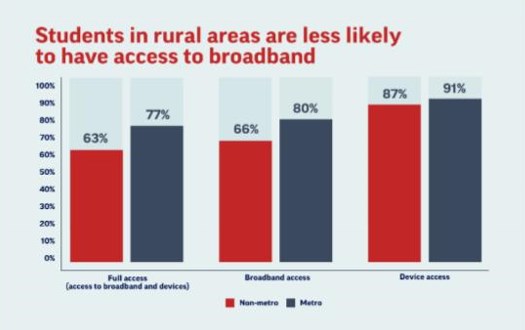
The Democratization of Connectivity

An estimated 30 million people can’t afford high-speed internet service, live where it isn’t available, or can’t use the access they do have because the quality of service is inadequate for remote work, telemedicine and distance learning. In a 2020 study, the National Education Association found that students in rural areas have marginally lower access to the internet and devices, but only 66% have broadband.¹
Deloitte analysis of broadband, economic and population data, reported in Broadband for All: charting a path to economic growth, shows “a strong correlation between broadband availability and jobs and GDP growth.”²
How can we elevate quality of life and make the most of economic opportunities in a digitally transformed world?
Democratizing connectivity – enabling affordable, ubiquitous broadband and closing the digital divide – is the answer.
Money, Digital Infrastructure and Innovation
There’s been a great deal of investment by both public and private sectors committed to solving the problem. From 2010 to 2020, more than $100 billion was spent in a mix of government programs.² The 2021 Bipartisan Infrastructure Law includes $65 million allocated to closing the digital divide, with state grants aimed at providing low-cost broadband services, monthly subsidies for low-income households, and projects such as online skills education for seniors.
A second component is fiber to everywhere, or FTTX. According to the Fiber Broadband Association 2021 Fiber Provider Study, 43% of U.S. homes have fiber connectivity (60.5 million, representing a 12% growth in 2021, the largest year-over-year increase).³ Continued expansion of fiber to the home and fiber to the enterprise, driven by ISPs such as Lumen, AT&T and Verizon as well as Tier 2 regional operators, will eventually make 90+% FTTX a reality.
Gary Bolton, President and CEO of the Fiber Broadband Association, frames up the potential FTTX could create: “When every community can leverage fiber optics for its critical infrastructure, we’ll open endless possibilities for prosperity.”⁴
The convergence of wireline and wireless communications, including fixed wireless, is the third part of the solution. Interoperability between wireline and wireless networks will become ever more critical for enabling end-to-end, distributed networks, with data centers at the core and at the edge. You’ll notice that the discussion is shifting slightly from broadband, although it is still relevant to core advantages: speed and reach. 5G networks are 10 times faster, support 10,000 times more data transport, and can handle 100 times more devices than 4G networks while enabling 1/50th the latency. 5G blurs the performance difference between mobile and tethered connections so much that the user experience is indistinguishable from one platform to the other.
As for reach, the GSMA predicts that 5G will account for as many as 1.2 billion connections by 2025. Ultimately, user adoption will show whether that prediction is accurate. As an aside, one reason the GSMA is referenced is that their mission includes “connectivity for good” by facilitating digital innovation to reduce inequalities in our world and address societal challenges such as digital inclusion.
Commitment Across the Digital Infrastructure Community
The final-ish element is collaboration among the community of stakeholders. The good news is that we are already seeing mobile network operators, physical infrastructure providers such as CoreSite and American Tower, and vertical industries as well as public sector entities investing resources and money to keep the 5G rollout moving.
Granted, it’s disruptive. It will call for rethinking where data centers are located, unprecedented network interoperability, new standards and regulations and, of course, another dimension of physical security and cybersecurity.
This will be challenging, but it’s important. It will radically change the interconnection model that we have in place today. It might prove to be the innovation needed to actualize all the use cases associated with digital transformation that we’ve been speculating about for a decade.
Let’s discuss bridging the digital divide, your role and the advantages your business should realize as the democratization of connectivity approaches. Get in touch to set up a call or data center tour today.
Also, members of the CoreSite team will be available during International Telecommunications Week 2022. You can schedule a meeting with us by following this link.











